The NSX Sport Hybrid Super Handling All-Wheel Drive (Sport Hybrid SH-AWD) power unit electrifies all phases of driving, whether accelerating, braking or cornering. Sport Hybrid SH‑AWD is a further evolution of Acura's highly regarded Super Handling All-Wheel Drive (SH-AWD). It is a first-of-its-kind technology in the exotic sports car segment. Instantaneous acceleration G force is experienced from the moment the driver touches the throttle, through the immediate torque response of three electric motors working in concert with the bespoke, twin‑turbocharged V6 and 9-speed dual clutch transmission (9DCT).
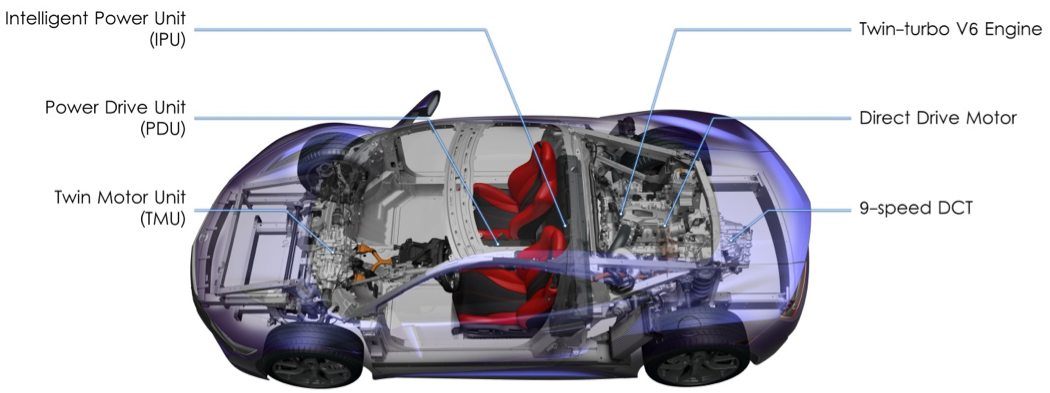
The NSX driver will experience peak performance from the Sport Hybrid SH-AWD power unit's marriage of mechanical and electrical components, working as a system to provide instant and linear acceleration, consistent and powerful braking and precise and predictable handling. Like the first‑generation NSX, this driver-centered supercar makes the most of every driver's capabilities while minimizing driver workload and virtually eliminating the conventional tradeoffs between limit performance and everyday driving pleasure.
- The twin-turbocharged V6 engine creates powerful thrust, while the electric Direct Drive Motor and TMU respond immediately to the driver's throttle demands.
- Rear axle torque flows through the new 9DCT; 1st gear is for maximum launch acceleration, the close-ratio gears (2nd–8th), making the most of the NSX power band, while 9th gear is optimized for effortless highway cruising.
- The front-mounted Twin Motor Unit (TMU) provides through-the-road "active all-wheel drive" with independent electric motors producing on-demand drive force at the front wheels. The TMU "direct yaw control" ability enhances agility, stability and cornering precision—the NSX driver can execute super-precise line tracing during cornering.
- The TMU provides regenerative braking force, supporting braking demands and direct yaw control with negative torque while recharging the hybrid battery.
- The TMU also provides electric vehicle operation in Quiet mode at speeds less than 50 mph for short distances.
Every time the driver makes a power demand, the TMU and the Direct Drive Motor immediately augment power production from the twin-turbocharged V6 engine, using the instantaneous torque that is an inherent characteristic of electric motors. Total system peak output is 573 horsepower—500 horsepower from the gasoline engine and 73 horsepower from the TMU and Direct Drive Motor.
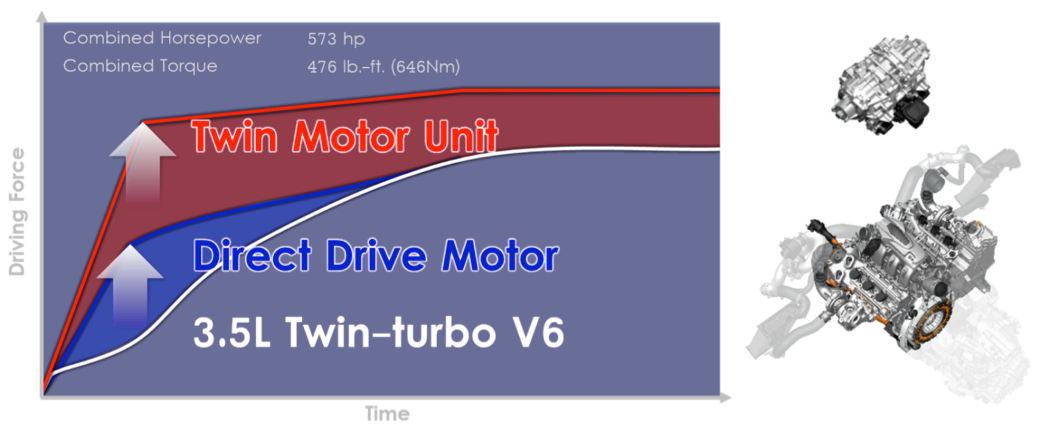
System drive force across time at wide open throttle
Twin-Turbocharged V6 Engine
At the heart of the NSX Sport Hybrid SH‑AWD power unit is a bespoke, twin-turbocharged, V6 engine that achieves high power and broad torque output.
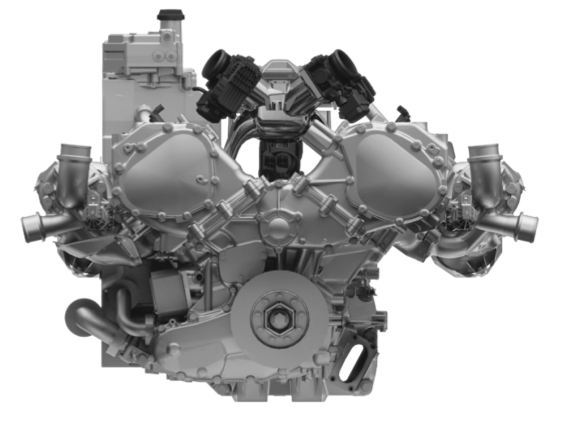
NSX twin-turbocharged V6 engine
With a compression ratio of 10.0:1, the NSX engine has a specific power output of more than 140 hp per liter of engine displacement, due to a number of advanced engine technologies.
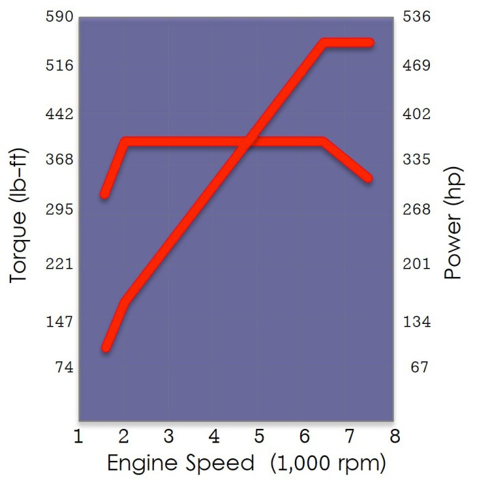
Acura Firsts for the NSX Engine
- Twin-turbo induction system
- Swing arm-type compact valvetrain system
- Three-piece water jacket (engine block and heads), including water jackets between the cylinder bores
- Plasma-transferred thermal spray‑coated cylinder walls
- Use of both direct and port fuel injection systems
- Two-stage chain drive system for the valvetrain
- Viscous damper mounted to the crankshaft
- Dry sump lubrication
Engine Highlights
The bespoke, twin-turbo system for the all-new engine offers a strong balance of high power with broad torque, high fuel efficiency and inherent packaging advantages. Through careful research and development, the NSX engine design and engineering team determined that the ideal boost pressure is 105 kPa (1.05 bar or 15.23 psi).
Increasing the engine intake air pressure also increases the intake air temperature. A high‑volumetric flow air-to-air intercooler dramatically reduces intake air temperature, while increasing the density of the air intake charge for maximum power.
Each turbocharger uses an electronic wastegate for fast response and precise control. The single-scroll turbocharger design uses smaller turbos to reduce weight and improve packaging, while still meeting power and performance benchmarks.
In an engineering and design exercise drawn straight from Acura's extensive racing experience, the cylinder heads fitted to the twin-turbocharged V6 are highly compact at a 75-degree angle. They include a compact valvetrain that uses swing arm-type valve actuators. The more compact head structure reduces the inertial weight of the valvetrain by 22 percent compared to a rocker arm-type design. This compact design together with the dry sump lubrication was focused on lowering the vehicle's center of gravity.
The cylinder heads utilize a three-piece water jacket for improved cooling efficiency and coolant flow control. The race-inspired cylinder head design also optimizes the swirling of intake air so that it mixes with fuel in a more ideal manner for improved combustion, improving efficiency and emissions performance.
Plasma-Transferred Thermal Spray-Coated Cylinder Walls
Most aluminum engines require a cast iron cylinder liner to provide sufficient wear resistance. Instead, engineers on the power unit development team applied a plasma‑transferred thermal spray to the cylinder walls. This recently‑developed technique offers 52 percent better heat transfer (thermal conductivity) and a nearly 7lb.-decrease in overall engine weight versus cast iron cylinder liners. Additional benefits of the plasma-transferred thermal spray‑coated cylinder walls include increased horsepower, torque and throttle response.
The plasma-transferred thermal spray process melts an atomized iron powder that can be sprayed onto the cylinder walls. A supersonic plasma jet is used to spray the molten material, stacking the tiny particles on top of each other to form a very thin and extremely wear-resistant coating. Eliminating cylinder liners allows additional water channels to be placed between the cylinder bores for improved cooling efficiency.
Intake and Exhaust Variable Valve Timing Control
The NSX engine incorporates intake and exhaust valve timing control (VTC) technology, which balances high torque and maximum power output with reduced exhaust emissions and superior fuel efficiency.
- At engine idle, VTC stabilizes combustion for smooth idling by minimizing intake and exhaust valve overlap, decreasing the amount of exhaust gas recirculation.
- During steady-state cruise or under light acceleration, the VTC system reduces exhaust emissions and engine pumping losses by optimizing valve overlap.
- Under wide open throttle at low engine speeds, the overlap of the intake and exhaust cam timing is expanded so that the turbochargers can work at maximum efficiency for optimal power delivery and responsiveness.
- When operating the engine at elevated rpms, overlap of the exhaust and intake timing is gradually reduced for improved volumetric efficiency to create maximum power.
Direct and Port Fuel Injection
The NSX engine combines both direct and port fuel injection systems to provide exceptional power production and emissions performance.
Direct injection is the primary means of fuel delivery within each cylinder, while port injection is used for additional power output in high-performance driving situations. The direct injection system electric fuel injectors are mounted in the cylinder head and spray a fine, highly atomized mist of fuel directly into each cylinder under very high pressure. This is done so that the fuel ignites almost instantaneously and completely, maximizing engine performance and fuel efficiency with reduced emissions. Under high‑performance demands, the port injection system supplements the direct injection system, feeding fuel into the intake ports where it mixes with the incoming air for increased power production.
In summary, by optimizing the direct and port injection system with the operation of the engine's twin turbochargers, the NSX Sport Hybrid SH-AWD power unit engineering and development team were able to:
- Optimize direct injection and high tumble airflow combustion process within each cylinder for outstanding * * emissions performance
- Improve combustion efficiency and power output, assisted by the high tumble intake port design
- Precisely supply the required amount of fuel for maximum power output
- Reduce the production of hydrocarbons and particulate by avoiding fuel wetting on the piston and cylinder sleeve
Dry Sump Lubrication
In another application of race-bred technology, the all-new NSX is the first production Acura vehicle to use a dry sump engine lubrication system. This system lowers the engine center of gravity by 2.4 in. (61 mm) while helping ensure consistent engine lubrication under extreme cornering load conditions. The dry sump lubrication system replaces the conventional oil pan with a separate oil reservoir and a dedicated chain-driven oil pump mounted directly to the lower engine block. Six separate scavenger pump impellers collect the oil, and two pump rotors feed it back into the oil tank.

Intake System
A two-into-one intake manifold design minimizes torque deviation between each bank of cylinders. Twin throttle bodies allow more air into the system and finer throttle control, while reducing the pulsation of the air.
Exhaust System
Compact and lightweight, the stainless steel exhaust system fitted to the NSX includes two catalytic converters per cylinder bank and four outlets, enhancing exhaust gas flow and reducing emissions. Silicon exhaust system mounts resist heat and offer a stout means of securing the exhaust system to the vehicle.
Engine Sound Management
Intake Sound Control
To enhance the driver's visceral experience inside the NSX cabin, the Integrated Dynamics System can be used to engage the new intake sound control and active exhaust valve systems to fine-tune cabin sound quality and volume to match the selected dynamic mode. The sound pressure level range within the cabin between wide open throttle in Track mode and electric vehicle cruising in Quiet mode is 25 (dB)—a wide range of audible sensation.
Intake sound control utilizes a pipe, connected directly to the engine's intake manifold, with an electrically-operated butterfly valve that can be opened and shut, depending on the Integrated Dynamics System setting. A diaphragm translates high-pressure air from the manifold to lower pressure sound waves. On the other side of the diaphragm, the single pipe then splits into two pipes that transmit sound to twin outlets in the rear uppermost portions of the cabin.
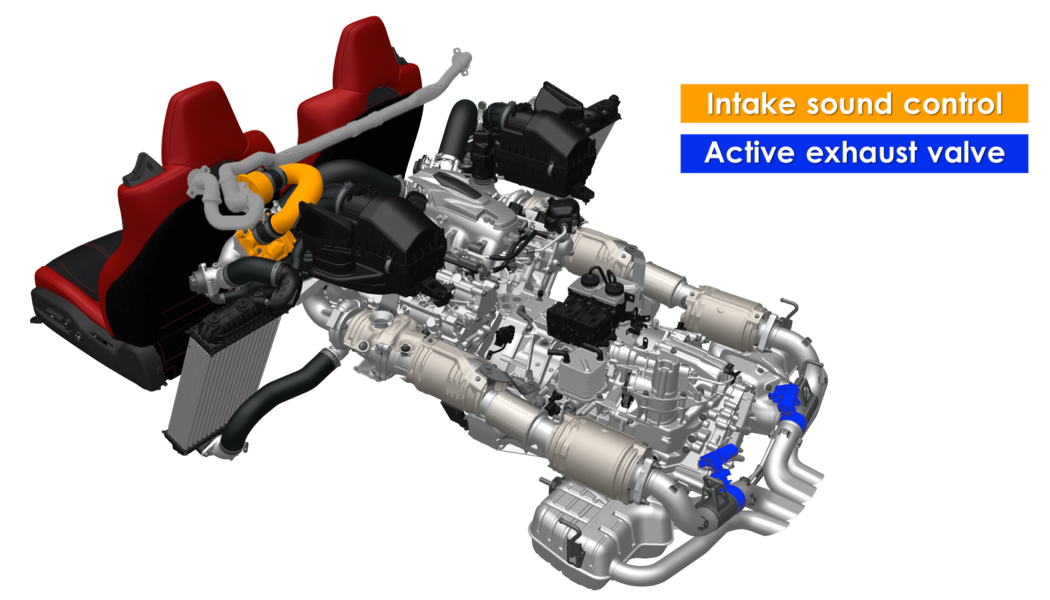
Active Exhaust Valve
The NSX active exhaust valve system is a complimentary component of the Integrated Dynamics system, offering quiet and refined driving or pulse-quickening sound at the will of the driver. Two electrically-operated valves are either open or closed based on driver throttle inputs and the selected mode of the Integrated Dynamics System setting.
- In Quiet mode, the exhaust valves are closed, and the exhaust gases are routed through silencers and out the two outboard exhaust pipes for a more subdued exhaust sound, allowing the driver to experience the intake soundtrack more clearly. Power and torque from the Sport Hybrid SH-AWD power unit is more than sufficient to effortlessly meet driver demands.
- In Sport mode, the exhaust valves are initially closed. They will open depending on how aggressively the driver accelerates.
- In Sport+ and Track modes, the exhaust valves are open, enabling maximum exhaust gas velocity out of all four exhaust pipes. This produces maximum engine performance and a full‑throated exhaust note.
The active exhaust valve system—together with the cabin sound modulation technologies of Active Sound Control and Intake Sound Control—serves to create a customizable auditory experience both in and outside of the NSX. From the hushed silence of Quiet mode to the full concerto of Track mode, the cabin fills with sounds every driving enthusiast loves to hear: the high‑performance "pop" from the exhaust when executing an upshift, the quick blip of the throttle upon downshifting and the occasional distinctive off-throttle burble that is a welcome reminder of the power and torque capability of the twin-turbocharged V6 engine.
Engine Balancing and Break-In
The NSX Sport Hybrid SH-AWD power unit development team further improved engine performance and refinement by reducing noise, vibration and harshness (NVH). The latest in engine balancing technology and a number of new processes were applied to achieve optimal balance, such as:
- Next-generation engine diagnostic equipment to more accurately measure engine imbalance
Variable bolt weights applied to the eight mounting holes on the flywheel - Nine mounting holes added to the crankshaft viscous damper that can be used for fine tuning
- Before being fitted into the NSX, the engine undergoes an important additional quality step called a "hot fire" break-in program. The engine is placed under load on a specially-designed engine dynamometer that simulates the equivalent of 150 miles of driving.
Direct Drive Motor
The Direct Drive Motor, packaged between the twin-turbocharged V6 engine and the 9DCT, provides additional torque and power assist to the rear wheels.
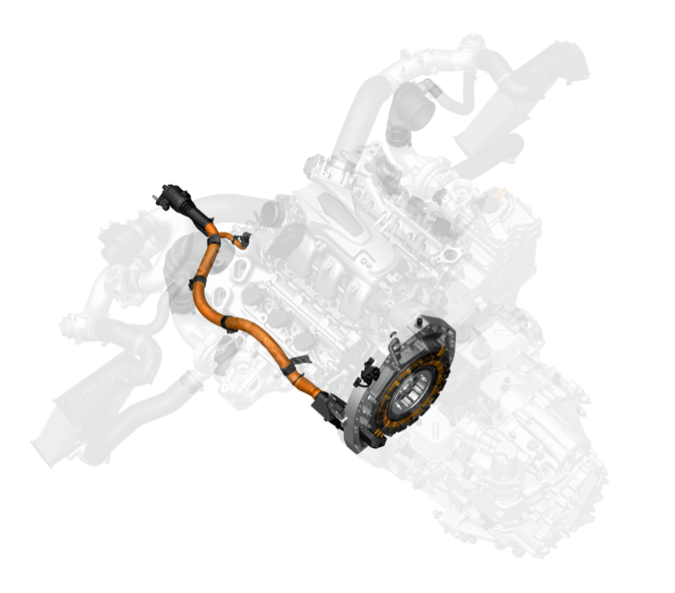
NSX Direct Drive Motor
To help eliminate the response delay typically associated with turbocharged engines, the Direct Drive Motor acts directly on the engine's crankshaft which, together with the front-mounted TMU, helps the NSX realize immediate, high-output and high-torque acceleration. The effectiveness of this design is particularly noticeable when accelerating from a standstill at low engine speeds.
The NSX utilizes its Direct Drive Motor to start the engine instead of using a conventional 12-volt engine starter motor. Eliminating the 12-volt starter ring gear reduced weight and layout complexity.
To help improve fuel efficiency, the NSX comes equipped with idle stop capability. Using the powerful Direct Drive Motor as an engine starter ensures that engine restarts are smooth and quick. Engine idle-stop is also fully integrated into the operation of the Automatic Brake Hold system.
Additionally, the Direct Drive Motor acts as a generator, helping to maintain the hybrid batteries at full charge to consistently support driver demands under almost any condition—even while lapping a track at full bore.
The Direct Drive Motor has a liquid cooling passage that provides consistent cooling, even when the system is being pushed to the limit, such as on a track excursion.
9-Speed Dual Clutch Transmission
The NSX's bespoke 9DCT plays a crucial role in dynamic performance, delivering lightning-fast and seamless up‑ and downshifts. The 9DCT works in concert with the Direct Drive Motor to make full use of the Sport Hybrid SH-AWD power unit's broad power band to produce quick and precise gear changes that support instant acceleration responses.
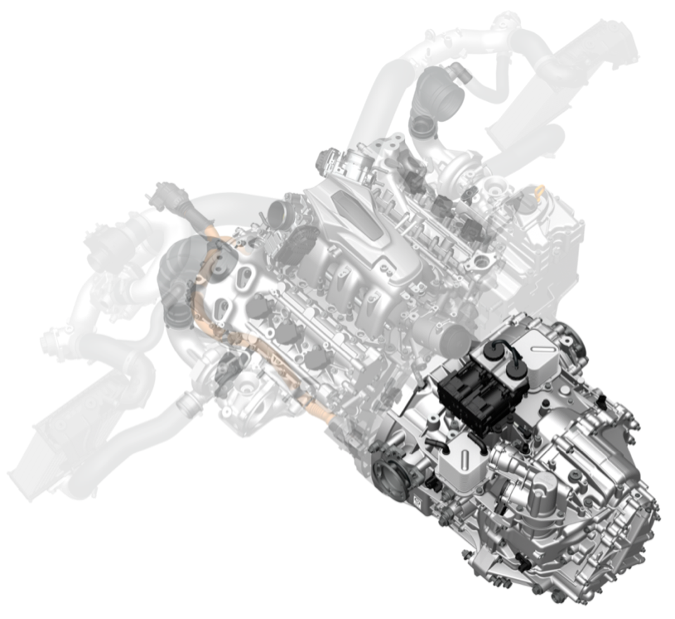
NSX 9DCT
The total ratio range with closely-spaced ratios enables the driver to extract maximum power from the NSX twin-turbo V6 engine. The transmission programming selects the right gear at the right time, or lets drivers select as they wish.
- First gear is configured for maximum vehicle launch acceleration.
- The close-ratio gears (2nd–8th) are matched to make the most of the Sport Hybrid SH-AWD power unit's power band. Top speed is achieved in 8th gear.
- High gear (9th) has been optimized for quiet cruising and fuel efficiency during steady-state highway driving. When driving in 9th gear on a level surface at 60 mph, the twin-turbocharged 3.5-liter, V6 engine is spinning at only 1,700 rpm.
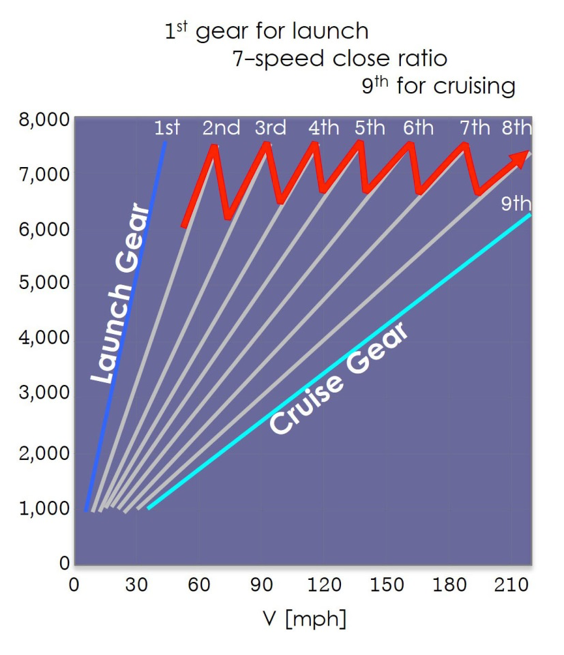
9DCT gear ratios
As a key component of the Sport Hybrid SH-AWD power unit's packaging, the 9DCT has been optimized for compact size, low mass and reduced overhang. The clutches and the differential are uniquely situated side-by-side in a common housing, reducing size and mass. The parallel shaft layout reduces overhang from the rear axle, enabling the 9DCT's center of mass to be moved forward.
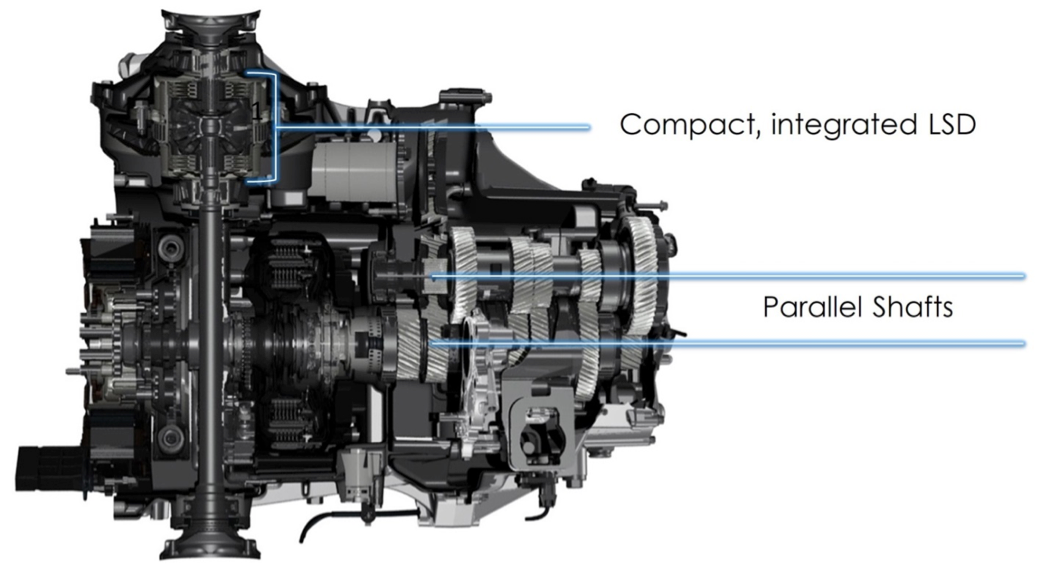
Top view of the 9DCT
Other advanced transmission technologies incorporated into the 9DCT include:
- Electronically-operated dual wet clutch, high-rigidity shift fork, double-cone synchronizer and electronic shift actuator work in concert to precisely synchronize shift timing with Sport Hybrid SH-AWD power unit torque for the quickest shifts possible
- Precision surfaced high-efficiency hypoid bevel gear tooth shape for smooth operation and minimal gear noise
- Use of two oil "rooms" within the transmission housing to support efficient and high-capacity cooling
- Clutch case and differential carrier integrated into one transmission cable for a lighter and more compact layout
- Lightweight, high-strength gearbox case
- Multi-plate LSD helps maximize available traction when accelerating and cornering at the limits of tire adhesion
- The addition of a lightweight single mass damper for low noise and vibration levels
- Exclusive new gear oil that improves lubrication while reducing drag throughout the gear train when compared to a conventional heavier gear oil that increases viscous drag
Shift Forks
The 9DCT features highly-rigid shift forks composed of a specialized, high-strength cast iron that provide a smooth and quick shift response. The 9DCT uses a total of five shift forks for the gear actuator system:
- A one-way clutch is used for 1st gear
- Four shift forks are used for 2nd–9th gears
- A fifth shift fork is used for Park and Reverse
Gear Actuators
A compact electric motor is used as a gear actuator instead of a conventional pneumatic or hydraulically-operated gear actuator. This system reduces weight by eliminating the high‑pressure hydraulic pump that is typically used in a gear actuator system. It also provides excellent reliability and system robustness, especially in frequent hard-driving sessions, compared to other available gear actuation systems.
Electric Clutch Actuator 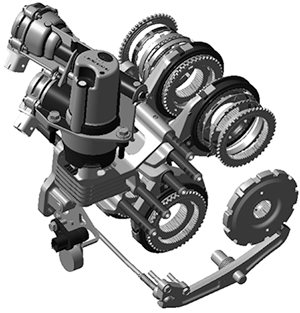
Like the electric motor-powered gear actuator, the electrically‑operated clutch actuator eliminates the need for a high-pressure hydraulic pump. The clutch is controlled by a closed-circuit hydrostatic structure, which enables oil pressure to be generated on demand, with greater efficiency.
Shift Characteristics Modification
Adding to the performance and shifting characteristics of the NSX advanced 9DCT, is the ability of the driver to change shift speed and performance with the Integrated Dynamics System:
- Quiet – Transmission shift map directs gear shifts at lower engine speeds
- Sport – Transmission allows the engine to rev more freely and makes gear changes in a higher rpm range
- Sport+ – Accommodates higher engine speed gear changes with quicker, more aggressively executed upshifts and downshifts
- Track – Fastest upshifting; 40 milliseconds faster than Sport+ settings
Mass Damper
The flywheel has been designed to act as a mass damper. This integrated part is one of the most lightweight components that could be added to minimize mechanical and harmonic vibration caused by oscillation, thereby greatly reducing noise, vibration and harshness (NVH) while helping to ensure the structural integrity and longevity of the transmission case.
Limited Slip Differential
The remarkably crisp turning capability and tractability of the all-new NSX is further enhanced by a mechanically-based limited slip differential (LSD).
The LSD torque bias ratio—an index for slip limit torque that compares torque shifted from a high rotation axle to a low rotation axle—has been optimized to provide two distinct LSD performance settings, ideal for when the wheels are being driven or when the vehicle is coasting.
Engineered to complement the TMU and VSA systems with precision torque vectoring and enhanced traction maintenance, the LSD helps advance vehicle performance in a number of driving situations:
- Under Braking or Deceleration Approaching a Turn – Increases engine brake torque on the outside tire and wheel for improved vehicle stability
- Straight-Line Driving – Pre-load torque enhances vehicle stability when driving in a straight line
- Under Acceleration while Turning – Overall vehicle tractability and poise is improved by shifting torque to the outside tire as traction from the inside tire decreases
Twin Motor Unit
The instant and linear acceleration of the new NSX, coupled with outstanding dynamic capability is enabled in part by its front-mounted TMU. Designed to be as small and lightweight as possible while delivering ample torque and power and precise torque vectoring to the front wheels, the TMU provides supplemental power in conjunction with the twin-turbocharged V6 engine and Direct Drive Motor for instantaneous acceleration whenever desired. The TMU can dynamically apportion its torque to create a yaw moment, enhancing cornering performance. Finally, the TMU recovers braking energy during deceleration to supply power to the hybrid batteries.
"Using Honda's original beta method to consider overall handling performance, we've been exploring direct yaw control torque vectoring for over two decades," said Acura NSX Global Development Leader Ted Klaus. "With the development of the Sport Hybrid Super Handling All-Wheel Drive System, we can take advantage of the superior responsiveness of the electric motor characteristics within the system to significantly expand the benefits of direct yaw control."

TMU location
Inside its die-cast aluminum housing are two electric motors positioned back-to-back. Each 36‑horsepower motor powers a single front wheel and can also apply negative torque to the same wheel. A gear mechanism allows the motors to decouple and still provide on-demand torque vectoring, helping to improve efficiency in certain conditions.
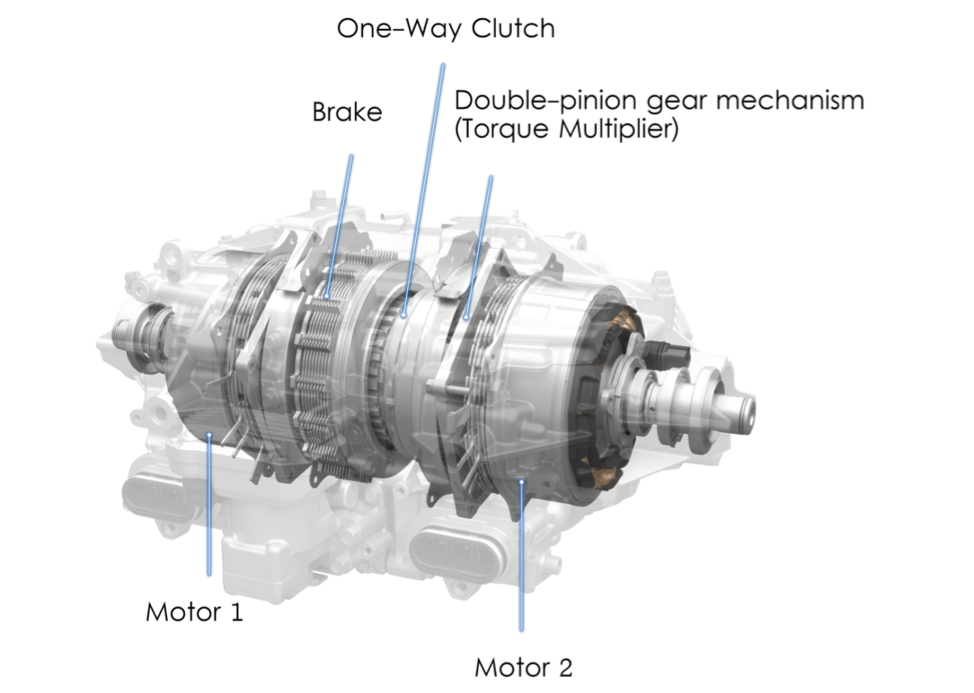
The TMU, along with the 109 lb.-ft. torque-generating Direct Drive Motor, provides the bulk of the accelerative force during initial acceleration from a standstill. After the first 0.15 seconds/0.1 G off the line, the high horsepower and torque from the twin-turbocharged V6 engine enters the fray, along with additional power from the Direct Drive Motor. From there, the engine exponentially increases its proportion of power contribution as the vehicle continues its rapid rate of acceleration.
The TMU is also a key motive force for driving in the Quiet mode setting of the Integrated Dynamics System, allowing for hushed, electric-only vehicle operation for short distances.
Intelligent Power Unit
Neatly packaged in the cabin, just forward of the rear bulkhead, the Intelligent Power Unit (IPU) acts as the primary heart and brains of the Sport Hybrid SH-AWD power unit, containing the following components:
- Lithium-ion battery pack
- Junction board
- High-voltage distribution bus bar
- DC/DC converter for 12V systems
- Electronic control units (ECU) for the electric motor and battery
When driving in Sport, Sport+ and Track modes, the vehicle's air conditioning system provides supplemental cooling of the IPU for optimal efficiency and performance. During development, the system was tested extensively in the desert heat of Dubai to ensure its proper function in extreme ambient temperatures.
Lithium-Ion Battery Pack
Packaged within the IPU is the lithium-ion battery pack that stores the electrical energy to power the TMU and Direct Drive Motor. The high-output lithium-ion battery pack consists of four modules, each with 18 individual battery cells contained within a specially-designed, caseless structure that utilizes the vehicle body itself for a lightweight yet sturdy housing.
Based on the latest advances in lithium-ion battery technology for automotive applications, both the positive and negative electrodes have been optimized for increased energy density and efficiency. Power output and efficiency of operation have been further improved by implementing a cooperative battery cooling system, fed by fresh cool air channeled into the passenger compartment via the vehicle's air conditioning. Cool air from within the cabin circulates through ducting to cool both the lithium-ion batteries and the DC/DC converter.
Power Drive Unit
The Power Drive Unit (PDU) incorporates three separate inverters to convert direct current to alternating current for use by the Sport Hybrid SH‑AWD power unit's three electric motors: the twin motors of the front-mounted TMU and the Direct Drive Motor. This compact "3-into-1" PDU design is critical to the system's compact packaging and the ability to mount it in the vehicle's center tunnel (beneath the center console).
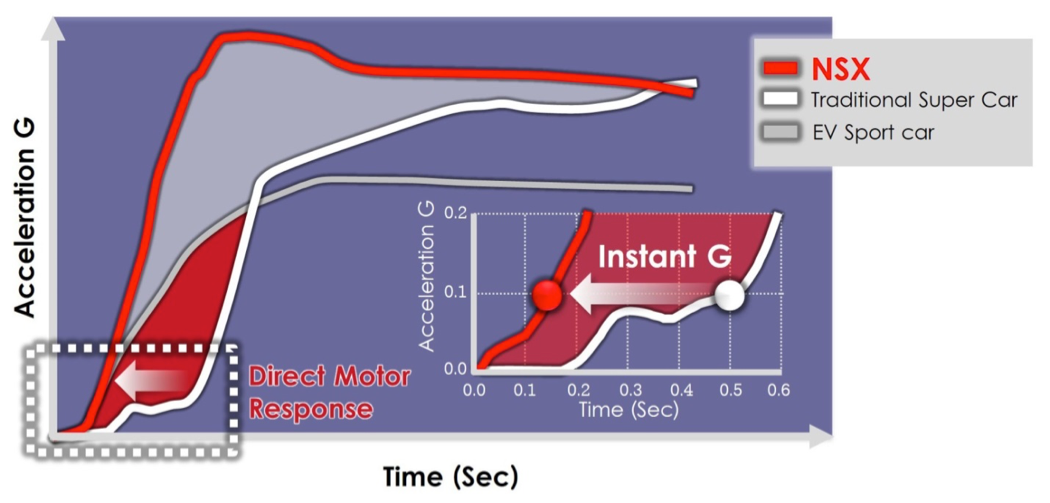
Specifications
| Engine | . |
|---|---|
| Type | Twin-turbocharged DOHC V6 |
| Layout | Longitudinally mid-mounted |
| Displacement | 3493 cc |
| Horsepower - SAE Net | 500 hp @ 6,500–7,500 rpm |
| Torque | 406 lb.-ft. @ 2,000–6,000 rpm |
| Maximum Engine Speed | 7,500 rpm |
| Specific Power Output | 143 hp/liter |
| Bore and Stroke | 3.6 in. x 3.5 in. |
| Compression Ratio | 10.0:1 |
| Twin Turbochargers | . |
| --------------------------- | ------------------ |
| Turbocharger Type | Single scroll |
| Maximum Boost Pressure | 105 kPa (1.05 bar) (15.23 psi) |
| Turbine Construction | Inconel nickel alloy |
| Wastegate Control | Electrical |
| Recirculation Valves | Air bypass type |
| Intercooler Type | Air-to-air |
| Engine Block and Internals | . |
| ------------------------- | ------------- |
| Cylinder Block and Head Material | Aluminum alloy |
| Cylinder Bore Lining | Plasma-transferred thermal spray |
| Cylinder Bank Angle | 75 degrees |
| Crankshaft Construction | Forged steel |
| Piston Construction | Cast aluminum with integrated cooling channel |
| Connecting Rod Construction | Forged steel |
| Valvetrain | . |
| -------------- | ------------- |
| Valvetrain | 24 Valve, IN/EX VTC, chain-driven camshafts |
| Intake Valve Construction | Forged steel |
| Exhaust Valve Construction | Forged steel, sodium-filled |
| Valve Included Angle | 30 degrees |
| Fuel and Intake System | . |
| ------------------- | -------------- |
| Fuel Injection | Direct and port injection systems |
| Throttle Control | Drive-by-Wire system |
| Fuel Requirement | Premium unleaded (93 octane recommended; 91 required) |
| Fuel Tank Capacity | 15.6 gal |
| EPA MPG Rating (city/hwy/combined) | 20/22/21 (estimated) |
| CARB Emission Rating | LEV-III SULEV 125 |
| Lubrication and Cooling | . |
| -------------------- | ---------------- |
| Lubrication | Dry sump system with 6-rotor scavenge pump |
| Oil Type | Synthetic 0W-40 |
| Cooling system | Liquid and oil cooling |
| Transmission and Rear Axle | . |
|---|---|
| Type | 9-speed dual clutch transmission (9DCT) |
| 1st Gear Ratio | 3.838 |
| 2nd | 2.433 |
| 3rd | 1.778 |
| 4th | 1.428 |
| 5th | 1.211 |
| 6th | 1.038 |
| 7th | 0.881 |
| 8th | 0.747 |
| 9th | 0.634 |
| Reverse | 2.395 |
| Rear Axle Ratio | 3.583 |
| LSD–Wet Multi‑Plate | Torque bias ratio: Drive 2.0; coast 2.6, 30 N-m pre-load |
| Twin Motor Unit (TMU) | . |
| ---------------- | ----------------- |
| Type | Permanent-magnet, oil-cooled electric motor/generator |
| Layout | Independent, twin motors packaged back-to-back with a 1‑way clutch, brake and planetary gear set |
| Horsepower @ rpm | 36 + 36 @ 4,000 |
| Torque @ rpm | 54 +54 lb.-ft. @ 0–2,000 |
| Direct Drive Motor | . |
| ------------------ | -------------- |
| Type | Permanent-magnet, water-cooled electric motor/generator |
| Layout | Direct drive, situated between engine and transmission |
| Horsepower @ rpm | 47 @ 3,000 |
| Torque @ rpm | 109 lb.-ft. @ 500–2,000 |
